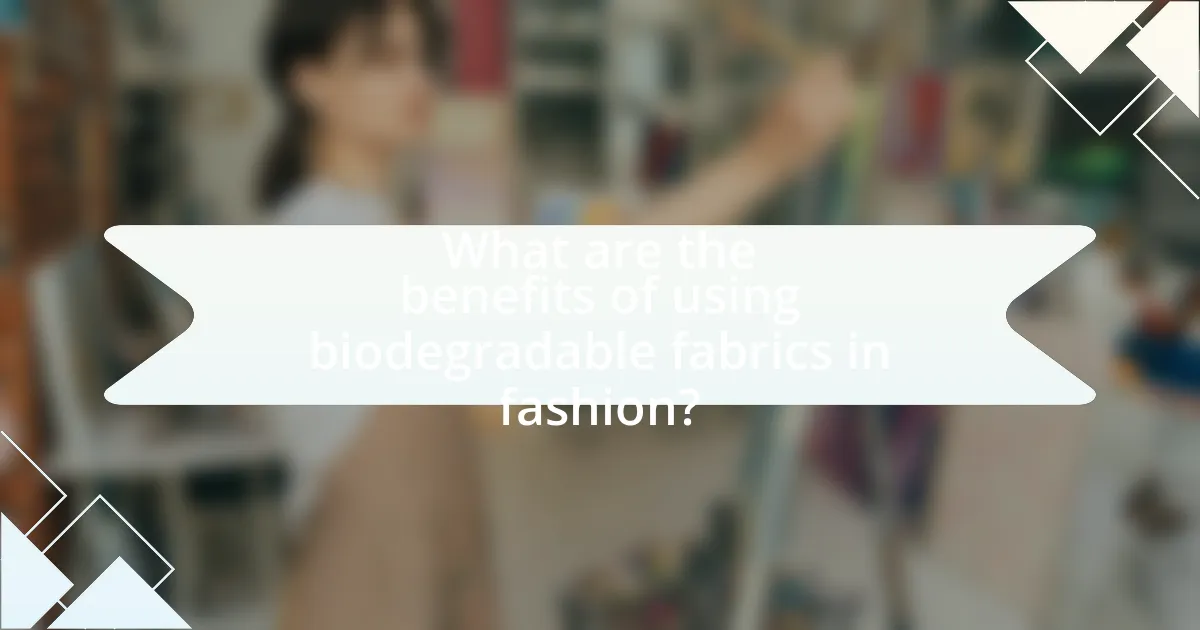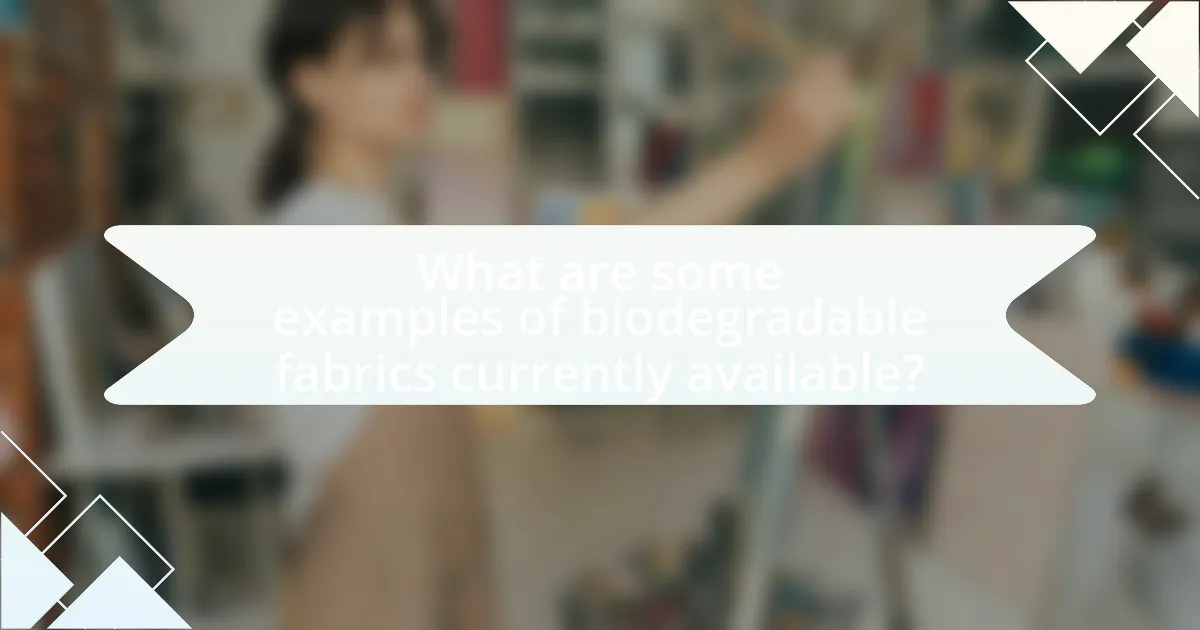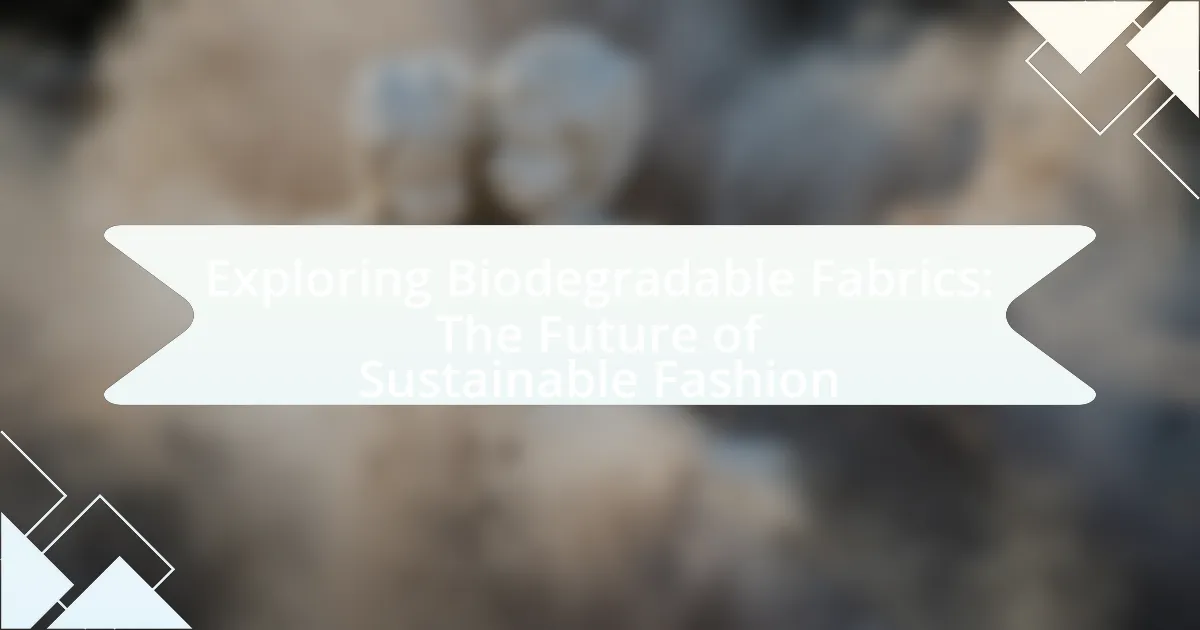Biodegradable fabrics are textiles made from natural fibers or specially designed synthetic materials that decompose over time through biological processes. This article explores the differences between biodegradable and traditional fabrics, highlighting the environmental benefits of using materials such as organic cotton, hemp, and Tencel in sustainable fashion. It discusses the challenges of adopting biodegradable fabrics, including production costs and consumer perceptions, while also examining innovations and market trends driving their use. Additionally, the article outlines practical tips for consumers to incorporate biodegradable fabrics into their wardrobes and the economic implications of transitioning to these eco-friendly materials in the fashion industry.

What are Biodegradable Fabrics?
Biodegradable fabrics are textiles made from natural fibers or synthetic materials designed to decompose over time through biological processes. These fabrics, such as cotton, linen, and certain biodegradable polyesters, break down into non-toxic components when exposed to environmental conditions like moisture and microorganisms. Research indicates that biodegradable fabrics can significantly reduce landfill waste and environmental pollution compared to conventional synthetic fabrics, which can take hundreds of years to decompose.
How are biodegradable fabrics different from traditional fabrics?
Biodegradable fabrics differ from traditional fabrics primarily in their ability to decompose naturally in the environment. Traditional fabrics, such as polyester and nylon, are made from synthetic materials that can take hundreds of years to break down, contributing to landfill waste and environmental pollution. In contrast, biodegradable fabrics, often derived from natural sources like cotton, hemp, or innovative materials such as Tencel, are designed to break down within a few months to a few years when exposed to the right conditions, such as moisture and microorganisms. This characteristic significantly reduces their environmental impact, aligning with sustainable fashion practices that aim to minimize waste and promote eco-friendly materials.
What materials are commonly used to create biodegradable fabrics?
Common materials used to create biodegradable fabrics include organic cotton, hemp, linen, Tencel (lyocell), and bamboo. Organic cotton is cultivated without synthetic pesticides, making it more environmentally friendly. Hemp is known for its durability and requires less water than conventional cotton. Linen, derived from flax plants, is biodegradable and has a low environmental impact. Tencel, produced from sustainably sourced wood pulp, is fully biodegradable and compostable. Bamboo grows rapidly and can be processed into biodegradable fibers, contributing to sustainable fabric options. These materials are increasingly favored in the fashion industry for their reduced environmental footprint and ability to decompose naturally.
How do the properties of biodegradable fabrics compare to synthetic options?
Biodegradable fabrics decompose naturally over time, while synthetic options, made from petroleum-based materials, persist in the environment for hundreds of years. Biodegradable fabrics, such as those made from organic cotton or Tencel, typically have lower environmental impacts, as they can break down into non-toxic components, contributing to soil health. In contrast, synthetic fabrics like polyester release microplastics during washing and contribute to pollution. Studies indicate that biodegradable fabrics can reduce landfill waste significantly, with some estimates suggesting that they can decompose within a few months to a few years, depending on conditions, whereas synthetic fabrics can take centuries to break down.
Why is the development of biodegradable fabrics important for sustainable fashion?
The development of biodegradable fabrics is crucial for sustainable fashion because it significantly reduces environmental impact by minimizing textile waste. Traditional fabrics, such as polyester and nylon, can take hundreds of years to decompose, contributing to landfill overflow and pollution. In contrast, biodegradable fabrics, made from natural fibers like organic cotton, hemp, or innovative materials like Tencel, break down more quickly and safely in the environment. Research indicates that the fashion industry is responsible for 10% of global carbon emissions and a significant portion of water pollution; thus, adopting biodegradable materials can help mitigate these issues by promoting a circular economy where materials return to the earth without harmful residues.
What environmental issues are associated with traditional fabric production?
Traditional fabric production is associated with several significant environmental issues, including water pollution, high water consumption, and the use of toxic chemicals. The dyeing and finishing processes often release harmful substances into waterways, affecting aquatic ecosystems and human health. For instance, the textile industry is responsible for about 20% of global industrial water pollution, primarily due to the discharge of untreated wastewater. Additionally, traditional fabric production typically requires large quantities of water; it takes approximately 7,000 liters of water to produce just one kilogram of cotton fabric. Furthermore, the use of pesticides and fertilizers in cotton farming contributes to soil degradation and biodiversity loss. These factors collectively highlight the environmental impact of conventional fabric manufacturing practices.
How do biodegradable fabrics contribute to reducing waste in the fashion industry?
Biodegradable fabrics significantly reduce waste in the fashion industry by decomposing naturally at the end of their life cycle, unlike conventional synthetic materials that can take hundreds of years to break down. This natural decomposition process minimizes landfill contributions and environmental pollution. For instance, a study published in the journal “Environmental Science & Technology” found that biodegradable textiles can reduce waste by up to 30% compared to traditional fabrics, as they return nutrients to the soil rather than contributing to persistent waste. By integrating biodegradable materials into production, the fashion industry can promote a circular economy, where products are designed for longevity and sustainability, ultimately leading to a decrease in overall textile waste.
What are the challenges in adopting biodegradable fabrics in fashion?
The challenges in adopting biodegradable fabrics in fashion include higher production costs, limited availability of raw materials, and consumer awareness. Higher production costs arise because biodegradable fabrics often require specialized processes and materials, making them more expensive than conventional fabrics. Limited availability of raw materials, such as organic cotton or hemp, restricts the scalability of biodegradable fabric production. Additionally, consumer awareness is a significant barrier; many consumers are not informed about the benefits of biodegradable fabrics, which affects demand. According to a 2021 report by the Ellen MacArthur Foundation, only 14% of consumers are aware of the environmental impact of textile waste, highlighting the need for increased education and marketing efforts to promote biodegradable options.
What are the limitations of current biodegradable fabric technologies?
Current biodegradable fabric technologies face several limitations, including degradation time, performance issues, and production costs. Degradation time can vary significantly, with some biodegradable fabrics taking months to years to break down, which may not align with consumer expectations for durability and usability. Performance issues arise as many biodegradable fabrics do not match the strength, elasticity, or moisture-wicking properties of conventional materials, limiting their application in high-performance clothing. Additionally, production costs for biodegradable fabrics are often higher than traditional fabrics, making them less accessible to manufacturers and consumers. These factors collectively hinder the widespread adoption of biodegradable fabrics in the fashion industry.
How do consumer perceptions affect the adoption of biodegradable fabrics?
Consumer perceptions significantly influence the adoption of biodegradable fabrics by shaping their willingness to purchase and use these materials. Positive perceptions, such as beliefs in environmental benefits and sustainability, can lead to increased demand for biodegradable fabrics, as consumers are more likely to choose products that align with their values. For instance, a study published in the Journal of Cleaner Production found that consumers who prioritize eco-friendliness are more inclined to buy biodegradable textiles, indicating a direct correlation between perception and purchasing behavior. Conversely, negative perceptions, such as doubts about the durability or performance of biodegradable fabrics, can hinder their acceptance in the market. Therefore, addressing consumer concerns and enhancing awareness about the advantages of biodegradable fabrics is crucial for fostering their adoption in the fashion industry.
How can the fashion industry transition to using biodegradable fabrics?
The fashion industry can transition to using biodegradable fabrics by investing in research and development of sustainable materials, implementing eco-friendly production processes, and fostering collaborations with innovative textile manufacturers. Research indicates that biodegradable fabrics, such as those made from organic cotton, hemp, and Tencel, can significantly reduce environmental impact, as they decompose naturally and do not contribute to landfill waste. For instance, a study published in the Journal of Cleaner Production highlights that using biodegradable materials can decrease the carbon footprint of clothing production by up to 30%. Additionally, brands can adopt circular economy principles, encouraging recycling and composting of garments, which further supports the shift towards biodegradable options.
What innovations are driving the future of biodegradable fabrics?
Innovations driving the future of biodegradable fabrics include the development of new materials such as mycelium, which is derived from fungi, and bio-based polymers like polylactic acid (PLA) made from corn starch. Mycelium fabrics are gaining attention for their ability to decompose naturally and their low environmental impact during production. Additionally, advancements in textile engineering are enabling the creation of blends that enhance biodegradability while maintaining durability and performance. Research indicates that these materials can break down within months in composting conditions, contrasting with traditional synthetic fabrics that can take hundreds of years to decompose.
How are brands incorporating biodegradable fabrics into their collections?
Brands are incorporating biodegradable fabrics into their collections by integrating materials such as organic cotton, Tencel, and hemp, which decompose naturally and reduce environmental impact. For instance, companies like Stella McCartney and Patagonia have adopted these fabrics to align with their sustainability goals, showcasing collections that emphasize eco-friendly production methods. Research indicates that the global market for biodegradable textiles is projected to grow significantly, reflecting a rising consumer demand for sustainable fashion options.
What role do technological advancements play in the development of biodegradable fabrics?
Technological advancements are crucial in the development of biodegradable fabrics as they enable the creation of innovative materials that decompose naturally without harming the environment. For instance, advancements in biotechnology have led to the development of fibers derived from natural sources, such as corn or sugarcane, which can break down more efficiently than traditional synthetic fabrics. Research indicates that these bio-based materials can reduce the environmental impact of textile waste, with studies showing that certain biodegradable fabrics can decompose within a few months under the right conditions, compared to hundreds of years for conventional plastics. Additionally, improvements in textile engineering allow for enhanced durability and functionality of biodegradable fabrics, making them more appealing for commercial use while maintaining their eco-friendly properties.

What are the benefits of using biodegradable fabrics in fashion?
Biodegradable fabrics in fashion offer significant environmental benefits by reducing waste and pollution. These materials decompose naturally, minimizing landfill contributions and the release of harmful chemicals associated with synthetic fabrics. For instance, studies show that conventional polyester can take hundreds of years to break down, while biodegradable options like organic cotton or Tencel can decompose within months under the right conditions. This rapid decomposition helps to lower the carbon footprint of the fashion industry, which is responsible for approximately 10% of global carbon emissions. Additionally, using biodegradable fabrics supports sustainable agricultural practices, as many of these materials are derived from renewable resources, promoting a circular economy in fashion.
How do biodegradable fabrics impact the lifecycle of clothing?
Biodegradable fabrics significantly enhance the lifecycle of clothing by enabling natural decomposition at the end of their use, thereby reducing landfill waste. Unlike conventional synthetic fabrics, which can take hundreds of years to break down, biodegradable materials such as organic cotton, hemp, and Tencel can decompose within months under the right conditions. This rapid breakdown minimizes environmental impact, as evidenced by a study published in the journal “Environmental Science & Technology,” which found that biodegradable textiles can reduce the accumulation of microplastics in ecosystems. By integrating biodegradable fabrics into clothing production, the fashion industry can promote a circular economy, where materials are returned to the earth, fostering sustainability and reducing the carbon footprint associated with textile waste.
What happens to biodegradable fabrics at the end of their life cycle?
Biodegradable fabrics decompose naturally at the end of their life cycle, breaking down into organic matter through the action of microorganisms. This process typically occurs in composting environments where conditions such as moisture, temperature, and microbial activity are optimal. Research indicates that materials like organic cotton, linen, and certain biodegradable synthetics can fully decompose within a few months to a few years, depending on the specific fabric and environmental conditions. For instance, a study published in the journal “Environmental Science & Technology” found that certain biodegradable textiles can degrade significantly faster than conventional fabrics, reducing landfill waste and contributing to soil health.
How do biodegradable fabrics affect the carbon footprint of fashion products?
Biodegradable fabrics significantly reduce the carbon footprint of fashion products by minimizing waste and greenhouse gas emissions during their lifecycle. These fabrics, such as organic cotton, Tencel, and hemp, decompose naturally, unlike conventional synthetic materials that can take hundreds of years to break down, contributing to landfill accumulation and methane emissions. According to a study by the Ellen MacArthur Foundation, transitioning to biodegradable materials can reduce the fashion industry’s carbon emissions by up to 44% by 2030. This reduction is achieved through lower energy consumption in production processes and the elimination of long-term waste, making biodegradable fabrics a crucial component in sustainable fashion practices.
What are the economic implications of switching to biodegradable fabrics?
Switching to biodegradable fabrics can lead to significant economic implications, including reduced waste management costs and potential new market opportunities. The transition to biodegradable materials can lower landfill expenses, as these fabrics decompose naturally, decreasing the burden on waste management systems. Additionally, the global biodegradable textiles market is projected to grow from $1.5 billion in 2020 to $3.5 billion by 2026, indicating a rising demand that can create jobs and stimulate economic growth in sustainable manufacturing sectors. Furthermore, companies adopting biodegradable fabrics may benefit from enhanced brand loyalty and consumer preference, as sustainability becomes a key purchasing factor for consumers.
How can brands balance cost and sustainability when using biodegradable fabrics?
Brands can balance cost and sustainability when using biodegradable fabrics by investing in efficient production processes and sourcing materials that minimize environmental impact while remaining economically viable. For instance, utilizing local suppliers can reduce transportation costs and emissions, while adopting innovative manufacturing techniques can lower waste and energy consumption. Research indicates that the global biodegradable fabrics market is projected to grow significantly, suggesting that economies of scale may reduce costs over time as demand increases. Additionally, brands can educate consumers on the long-term benefits of biodegradable fabrics, potentially allowing for a premium pricing strategy that supports sustainability initiatives without sacrificing profitability.
What market trends are emerging around biodegradable fabrics?
Emerging market trends around biodegradable fabrics include increased consumer demand for sustainable materials, innovation in production technologies, and a shift towards circular fashion practices. Consumers are increasingly prioritizing eco-friendly products, with a report from McKinsey indicating that 67% of consumers consider sustainability when making a purchase. Additionally, advancements in biotechnology are leading to the development of new biodegradable materials, such as mycelium and bio-based polymers, which are gaining traction in the fashion industry. Furthermore, brands are adopting circular economy principles, focusing on recycling and composting, as evidenced by initiatives from companies like Stella McCartney and Adidas, which aim to reduce waste and promote sustainability in their supply chains.

What are some examples of biodegradable fabrics currently available?
Some examples of biodegradable fabrics currently available include organic cotton, hemp, linen, and Tencel. Organic cotton is cultivated without synthetic pesticides, making it more environmentally friendly and biodegradable. Hemp is known for its durability and requires minimal water and chemicals during growth, contributing to its biodegradability. Linen, made from flax plants, is also biodegradable and has a low environmental impact. Tencel, produced from sustainably sourced wood pulp, is biodegradable and manufactured in a closed-loop process that recycles water and solvents. These fabrics are increasingly used in sustainable fashion, aligning with eco-friendly practices.
What types of biodegradable fabrics are being used in the industry today?
Biodegradable fabrics currently used in the industry include organic cotton, hemp, Tencel (lyocell), and biodegradable polyester. Organic cotton is cultivated without synthetic pesticides, making it more environmentally friendly. Hemp is known for its durability and requires less water and no pesticides. Tencel, derived from sustainably sourced wood pulp, is fully biodegradable and produced in a closed-loop process that recycles water and solvents. Biodegradable polyester, often made from renewable resources, can decompose under specific conditions, reducing environmental impact. These fabrics contribute to sustainable fashion by minimizing waste and promoting eco-friendly practices in textile production.
How do these fabrics perform in terms of durability and comfort?
Biodegradable fabrics generally exhibit moderate durability and high comfort. For instance, materials like organic cotton and Tencel are known for their softness and breathability, enhancing comfort for wearers. However, their durability can vary; while organic cotton is strong and long-lasting, Tencel is less durable when exposed to harsh conditions. Research indicates that Tencel has a tensile strength comparable to cotton, but it may degrade faster under certain environmental factors. Thus, while these fabrics provide comfort through their soft textures and moisture-wicking properties, their durability is often influenced by the specific type of biodegradable material used and the conditions they are subjected to.
What brands are leading the way in using biodegradable fabrics?
Brands leading the way in using biodegradable fabrics include Stella McCartney, Patagonia, and Eileen Fisher. Stella McCartney has been a pioneer in sustainable fashion, utilizing biodegradable materials like organic cotton and Tencel in her collections. Patagonia focuses on eco-friendly practices and incorporates biodegradable fabrics such as hemp and organic cotton into its products. Eileen Fisher emphasizes sustainability by using biodegradable fibers like linen and organic cotton, promoting a circular economy in fashion. These brands exemplify the shift towards environmentally responsible materials in the fashion industry.
How can consumers identify and choose biodegradable fabrics?
Consumers can identify and choose biodegradable fabrics by looking for specific materials and certifications. Fabrics made from natural fibers such as cotton, linen, hemp, and Tencel are typically biodegradable, as they decompose naturally. Additionally, consumers should seek certifications like Global Organic Textile Standard (GOTS) or OEKO-TEX, which indicate environmentally friendly practices in production. Research shows that biodegradable fabrics can break down within a few months to a few years, depending on conditions, making them a sustainable choice for fashion.
What labels or certifications should consumers look for?
Consumers should look for labels and certifications such as Global Organic Textile Standard (GOTS), OEKO-TEX Standard 100, and Cradle to Cradle Certified. GOTS ensures that textiles are made from organic fibers and meet environmental and social criteria, while OEKO-TEX Standard 100 certifies that textiles are free from harmful substances. Cradle to Cradle Certified indicates that a product is designed for a circular economy, promoting sustainability and safety. These certifications provide assurance of the environmental and ethical standards of biodegradable fabrics in sustainable fashion.
How can consumers support brands that prioritize biodegradable fabrics?
Consumers can support brands that prioritize biodegradable fabrics by choosing to purchase their products and advocating for sustainable practices. By selecting items made from biodegradable materials, consumers directly contribute to the demand for eco-friendly options, which encourages brands to continue and expand their sustainable offerings. Additionally, consumers can engage in discussions on social media, share information about these brands, and participate in campaigns that promote biodegradable fabrics, thereby raising awareness and influencing others to make environmentally conscious choices. Research indicates that the global market for biodegradable textiles is expected to grow significantly, reflecting a rising consumer preference for sustainable fashion, which further validates the impact of consumer support on brand practices.
What are practical tips for incorporating biodegradable fabrics into your wardrobe?
To incorporate biodegradable fabrics into your wardrobe, prioritize purchasing clothing made from materials such as organic cotton, linen, hemp, and Tencel, which are known for their biodegradability. Research brands that specialize in sustainable fashion, as many now offer collections featuring these eco-friendly fabrics. Additionally, consider thrifting or buying second-hand clothing, as this extends the life cycle of garments and often includes biodegradable options. Educate yourself on fabric care to ensure longevity, as proper maintenance can enhance the lifespan of biodegradable materials. Lastly, support local artisans or small businesses that focus on sustainable practices, as they often use biodegradable fabrics in their designs.

Leave a Reply